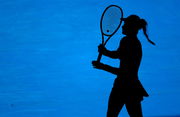
Imago
Tennis : Wimbledon -2025 – ITF – Tennis – Wimbledon – ITF – Taylor Fritz – Usa GB PUBLICATIONxNOTxINxFRAxBEL Copyright: xChryslenexCaillaudx/xPznewsx

Imago
Tennis : Wimbledon -2025 – ITF – Tennis – Wimbledon – ITF – Taylor Fritz – Usa GB PUBLICATIONxNOTxINxFRAxBEL Copyright: xChryslenexCaillaudx/xPznewsx
Tennis is known as one of the world’s most traditional sports, but even this classic game has embraced modern tech with Hawk-Eye. Simply put, it’s an electronic line-calling system designed to wipe out human errors on the court. Though many tournaments have adopted it, players still run into issues during matches. Now, the ITF seems ready to roll out something new to keep the game moving forward.
Watch What’s Trending Now!
On July 23, according to Reuters, an exciting shake-up in tennis was revealed as Electronic Line Calling (ELC) is expanding beyond the Grand Slams and elite tour events. The International Tennis Federation (ITF) unveiled a brand-new three-tier classification system to make this technology more accessible. Now, ELC systems will be categorized as Gold, Silver, or Bronze, covering a broader range of tournaments. This upgrade comes after a joint effort among the Grand Slams, ATP, WTA, and the ITF to grow the tool’s reach.
Gold-level systems will continue shining at top-tier events like the Grand Slams, ATP and WTA Tours, Billie Jean King Cup, and Davis Cup. Meanwhile, Silver systems will serve second-tier competitions such as the ITF World Tennis Tour. Bronze systems are perfect for national-level tournaments, designed to work with smaller budgets and less infrastructure—plus, no off-court operators are needed. Basically, this means even smaller tournaments can now benefit from sophisticated line-calling tech.
ADVERTISEMENT
The ITF stressed that every system, whether Gold, Silver, or Bronze, will meet “accuracy, reliability, suitability and practicality” standards. “Systems that meet the relevant standards are awarded classification at the appropriate level and are eligible to be used in events sanctioned by the international governing bodies,” they explained. The goal? To unify how all the big tennis organizations evaluate and keep an eye on these ELC systems around the world.
While the Australian Open, U.S. Open, and Wimbledon have fully embraced ELC by replacing human line judges, the French Open still holds onto tradition. However, Wimbledon’s switch to ELC this year added some drama, drawing mixed reviews from players who weren’t too happy with how things played out.
ADVERTISEMENT
Taylor Fritz calls out the ELC at Wimbledon
During the Wimbledon quarter-finals, a glitch with the electronic line-calling system caused a point replay in Fritz’s match against Karen Khachanov. Fritz led two sets to none before losing the third. At 15-0 in the fourth, umpire Louise Azemar-Engzell stopped play, announcing, “Ladies and gentlemen, we will replay the last point because of a malfunction. The system is now working.”

Imago
Taylor Fritz during his third round match Wimbledon Tennis Championships, Day 5, The All England Lawn Tennis and Croquet Club, London, UK – 04 Jul 2025London The All England Lawn Tennis and United Kingdom PUBLICATIONxINxGERxSUIxAUTxHUNxGRExMLTxCYPxROUxBULxUAExKSAxCHNxDENxINDxITAxPORxESPxSWExTURxMEXxCOLxVENxPERxECUxBRAxARGxCHIxURUxPARxPANxONLY Copyright: xJavierxGarcia/Shutterstockx 15384469fj
The All England Club explained Fritz’s service started while the ball-tracking system was still crossing the net, causing the error. Taylor Fritz won 6-3, 6-4, 1-6, 7-6 (7-4) to reach the semis.
ADVERTISEMENT
Wimbledon organizers apologized after human error shut off the system during Anastasia Pavlyuchenkova’s match with Britain’s Sonay Kartal, missing three calls. The All England Club stated they “continue to have full confidence in the accuracy of the ball-tracking technology” and made changes to avoid operator mistakes.
Top Stories
Novak Djokovic Makes a Bold Coaching Move As He Looks the Challenge Carlos Alcaraz & Jannik Sinner in 2026

Russian Tennis Hit Hard as Another WTA Player Forfeits Citizenship

Carlos Alcaraz and Jannik Sinner Take Bizarre On-Court Decision as Australian Open Countdown Begins

Ex-WTA Pro Calls Out Media Houses After Personal Rumors Cross the Line

Anhelina Kalinina Pulls Off Major Comeback Feat Months After Retiring Due to Brutal Arm Injury

Khachanov said, “I’m more for line umpires, to be honest. You feel a little bit the court is too big, too alone without line umpires,” adding, “AI and electronic line calls have to be very precise and no mistakes, but we’ve seen a couple. That’s questionable why this is happening.” Opinions differ, but Wimbledon’s mix of tradition and technology certainly stirred up conversation among others.
ADVERTISEMENT
More players call out the ELC at SW19
Emma Raducanu didn’t hold back after her latest match, calling electronic line calls “dodgy” and revealing that complaints are a hot topic in the locker room. She was particularly fired up when a shot from Aryna Sabalenka, her rival on Friday, was judged to have clipped the line. “That call was for sure out,” Raducanu said after her intense 7-6 (8-6) 6-4 loss, where she gave the world number one a real test. When asked if she trusts the new technology, she didn’t even hesitate: “No, I don’t—I think the other players would say the same thing, there were some pretty dodgy ones but what can you do?”
Even Jack Draper, Britain’s men’s number one, echoed her skepticism. After his defeat to Marin Cilic on Thursday, he shrugged and admitted, “I don’t think it’s 100% accurate, in all honesty. A couple of the ones today showed a mark on the court. There’s no way the chalk would have showed.” Even some of the players who back the system, like Iga Swiatek, admit they have their doubts but say they “have to trust them.”
ADVERTISEMENT
But it isn’t just about the accuracy. The new system’s volume—or lack thereof—has also annoyed players. Raducanu pointed out, “Some of them were a little bit quiet or dulled out by the crowd.” With Centre Court’s roof closed and the home fans roaring, she just couldn’t hear all the calls. “But overall you kind of have an idea if the ball was in or out. And then hope that Hawk-Eye calls it the same.” Even Sabalenka agreed, admitting the stadium noise left everyone confused for a few seconds until the scoreboard made it clear who won the point.
Other stories are making the rounds too. Ben Shelton had to rush his match because the AI line system was on the verge of shutting down as the sun set. Meanwhile, some players said the new speaker system just isn’t loud enough, and a deaf player highlighted the real challenge: without the old human hand signals, she often doesn’t know if she’s even won the point.
Now, with the US Open on the horizon, the big question looms: Can they iron out these high-tech wrinkles in time for the next major showdown?
ADVERTISEMENT
ADVERTISEMENT
ADVERTISEMENT
ADVERTISEMENT

